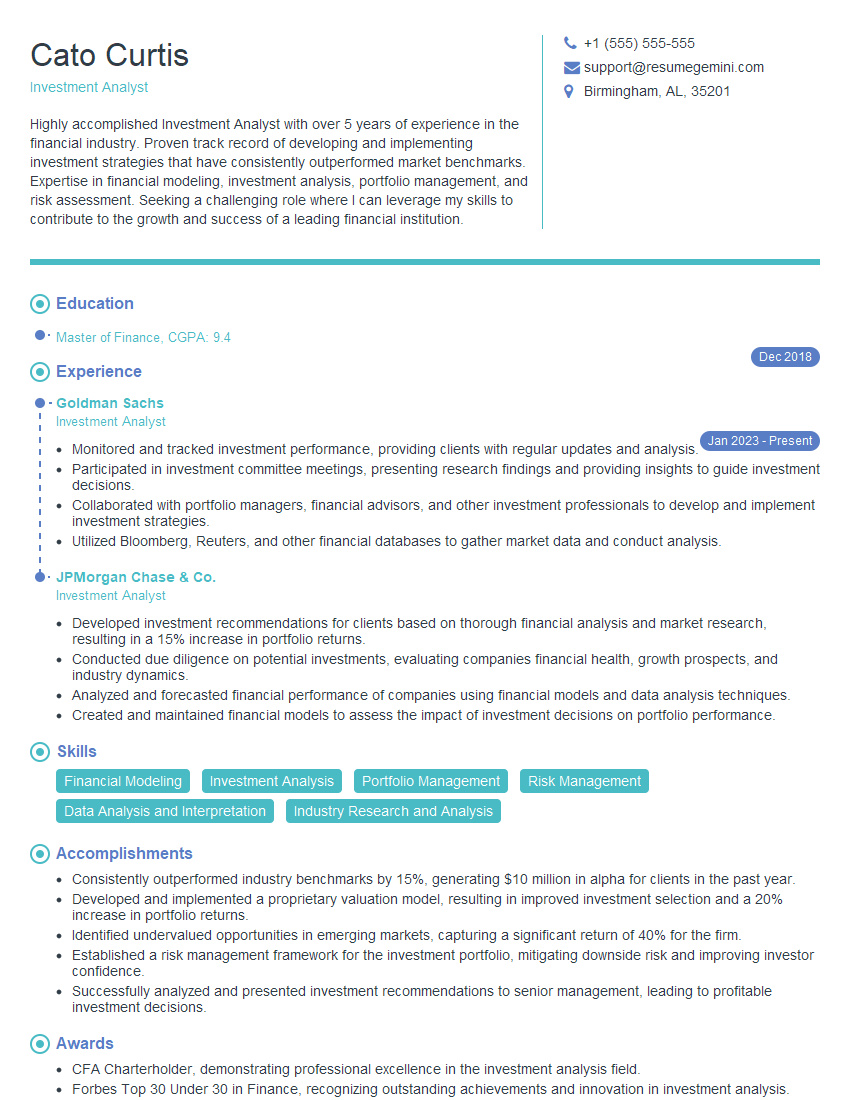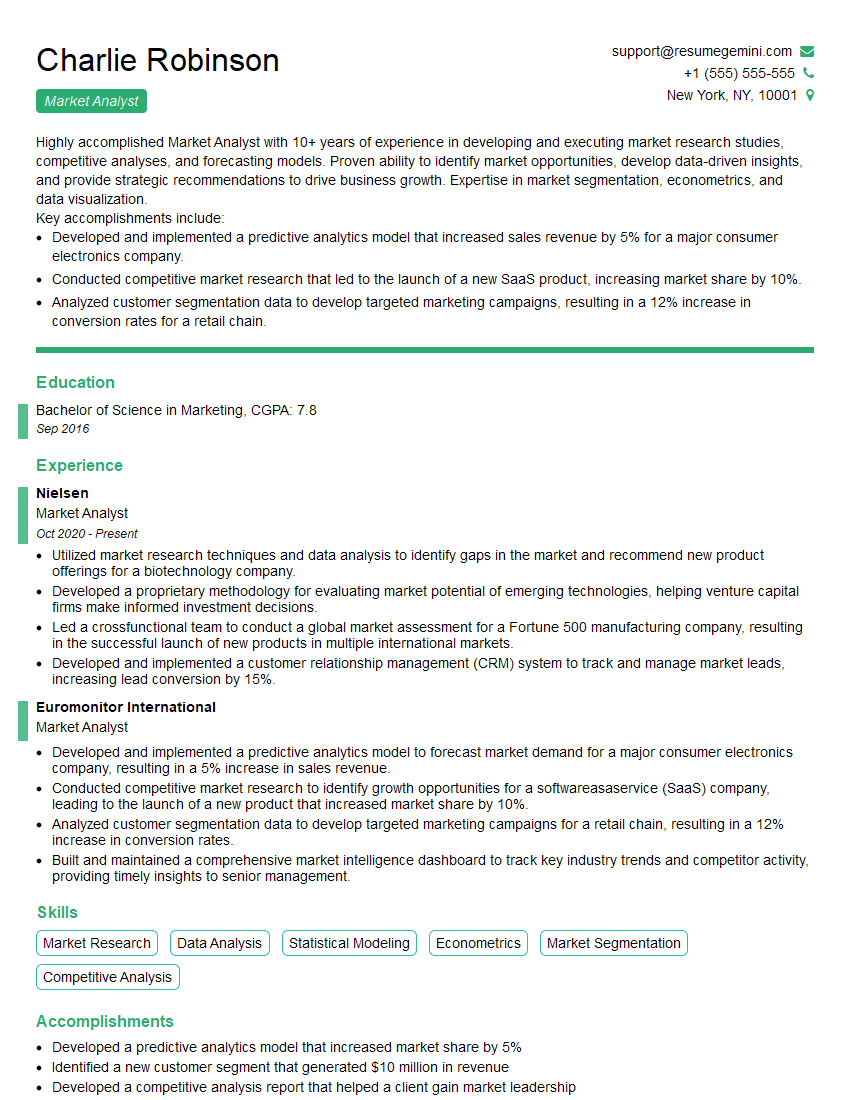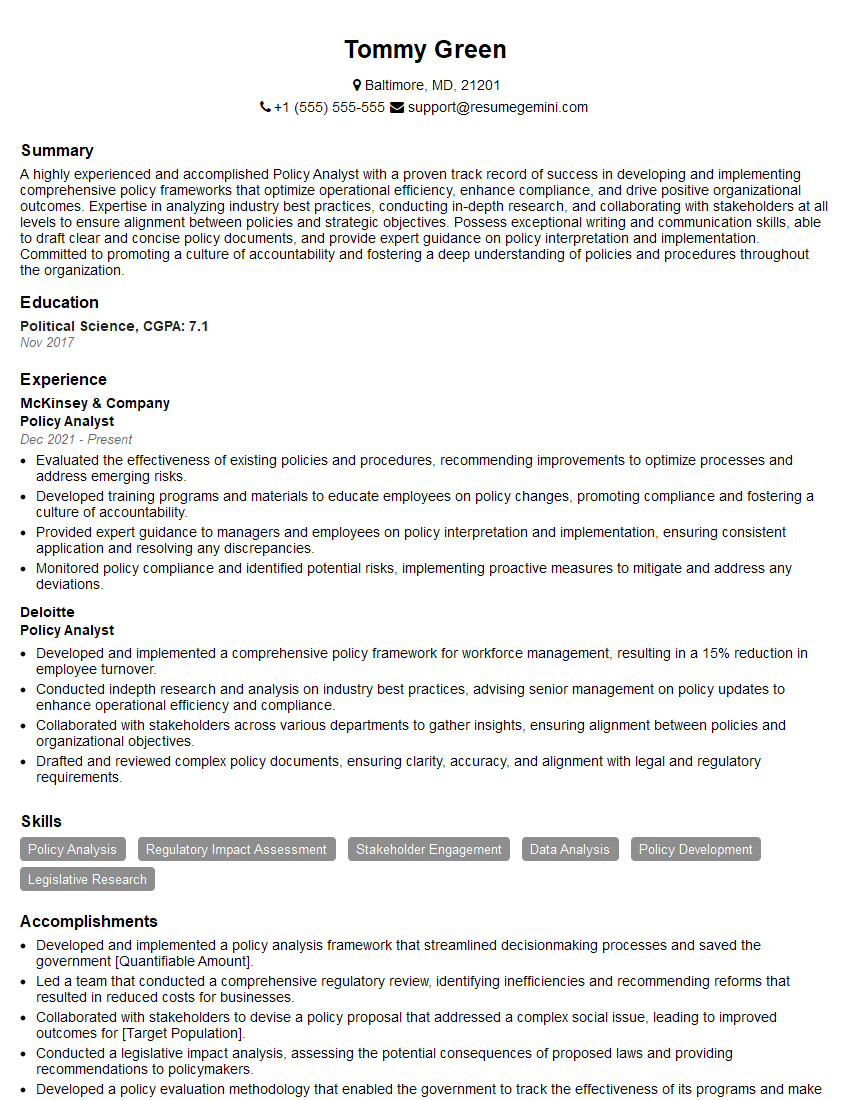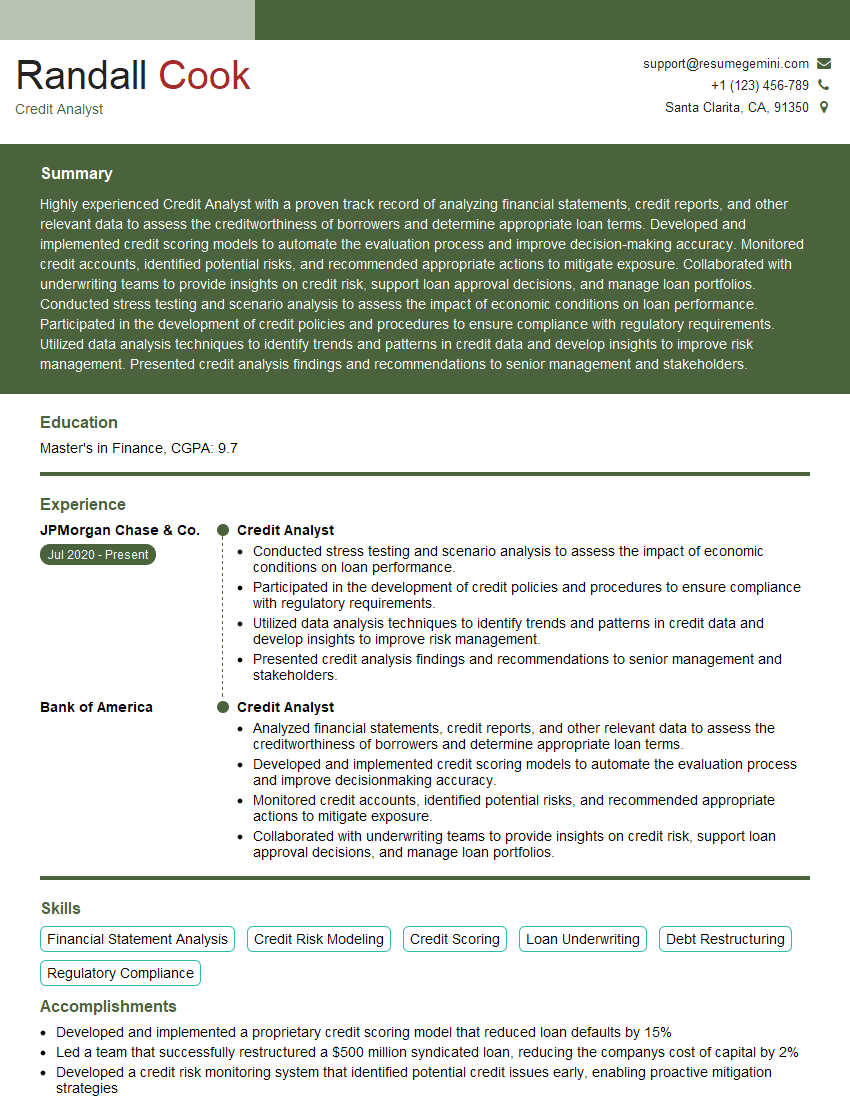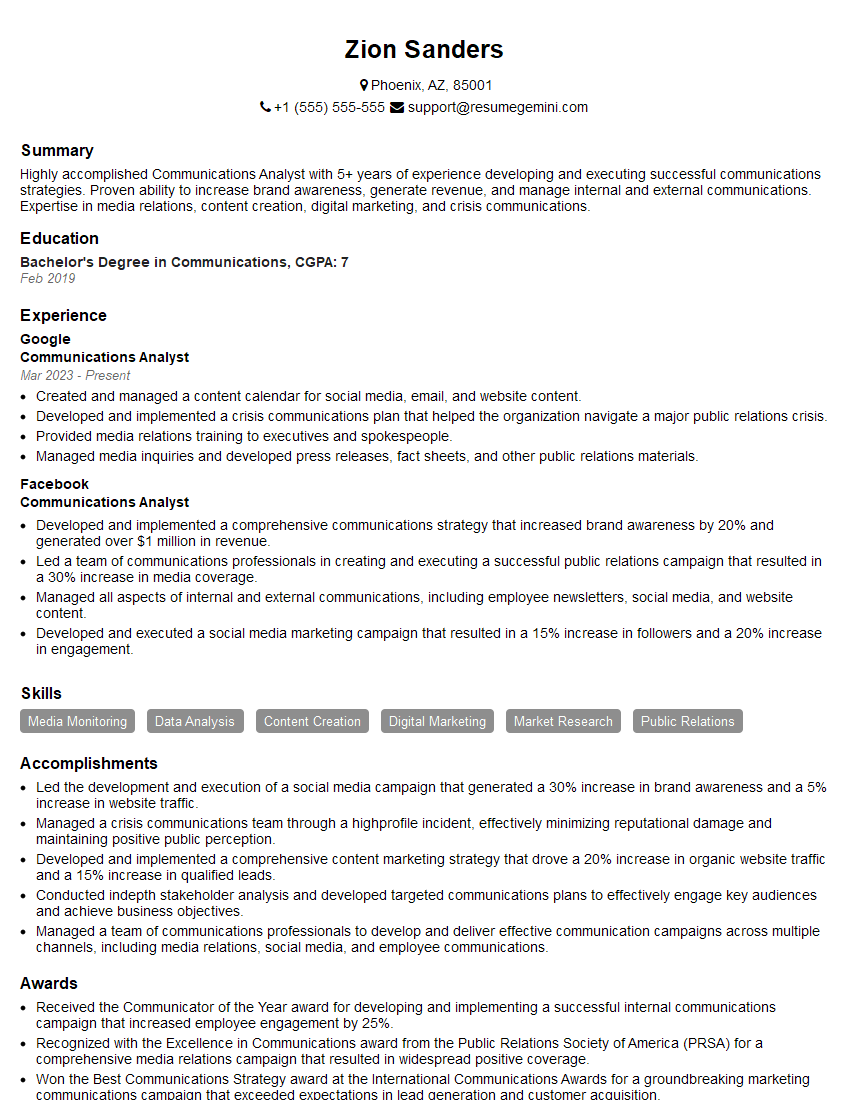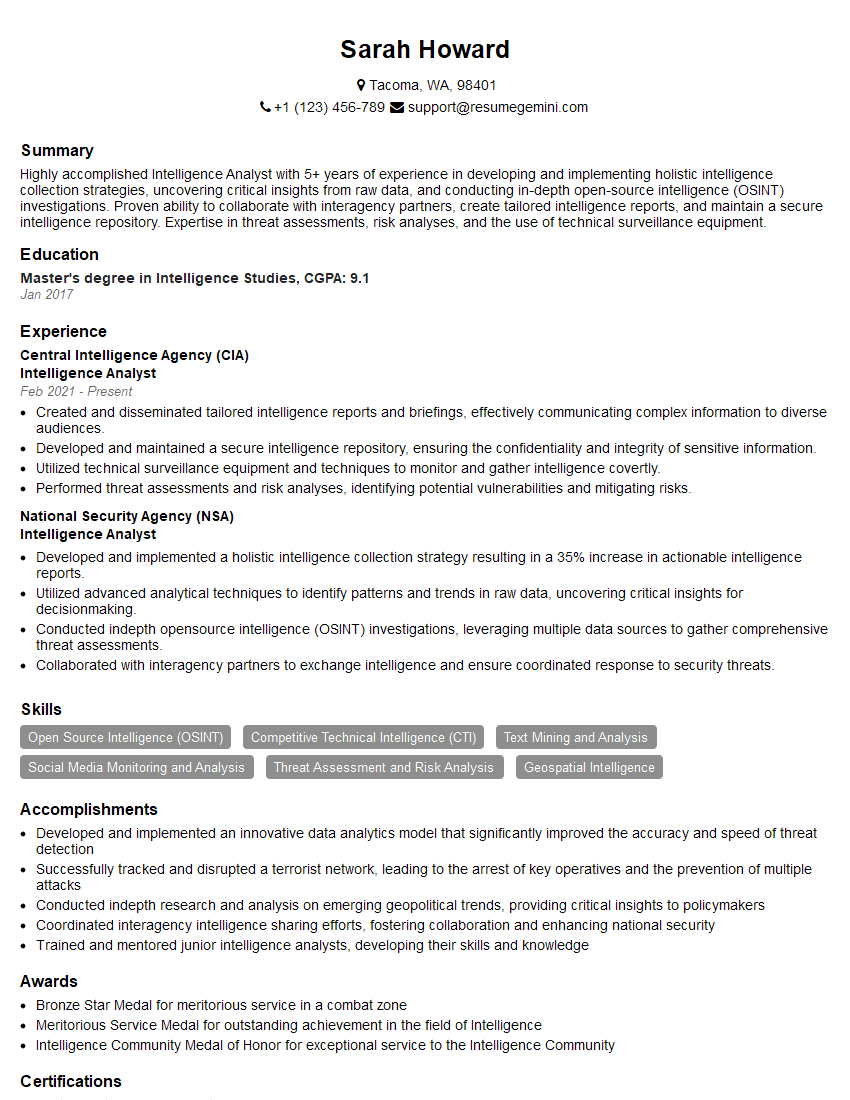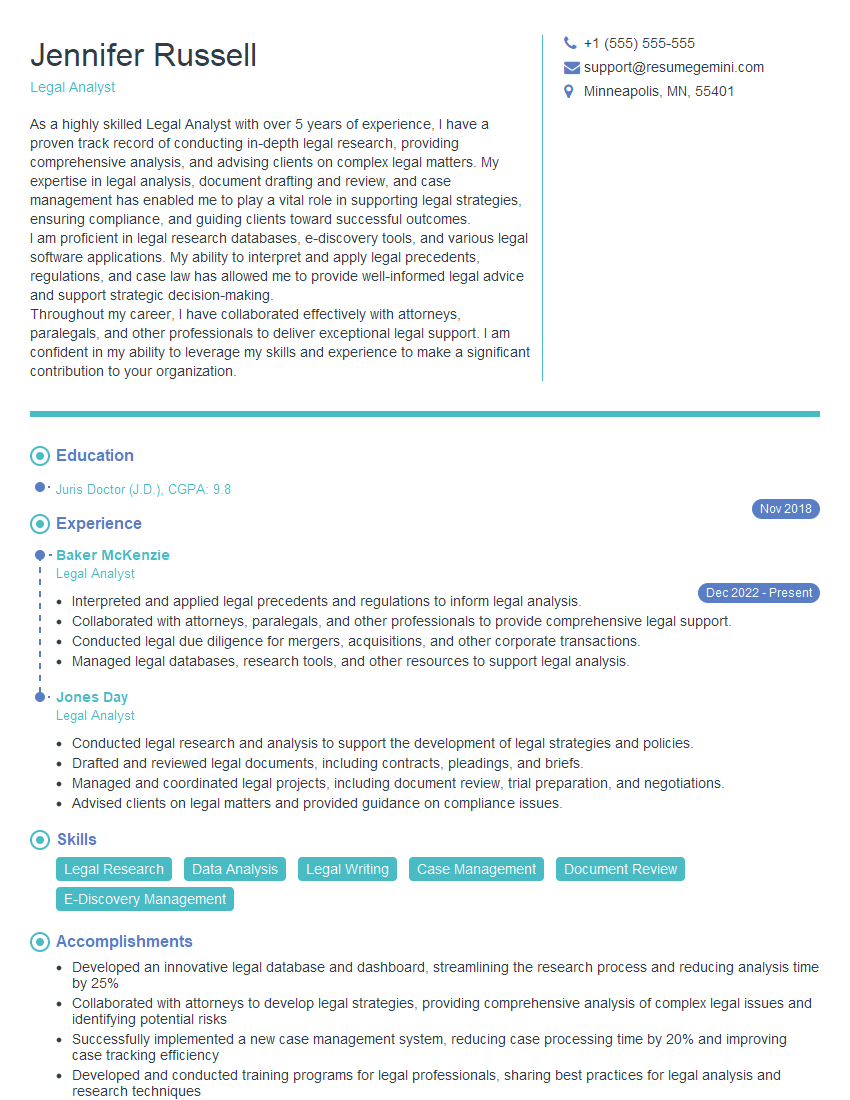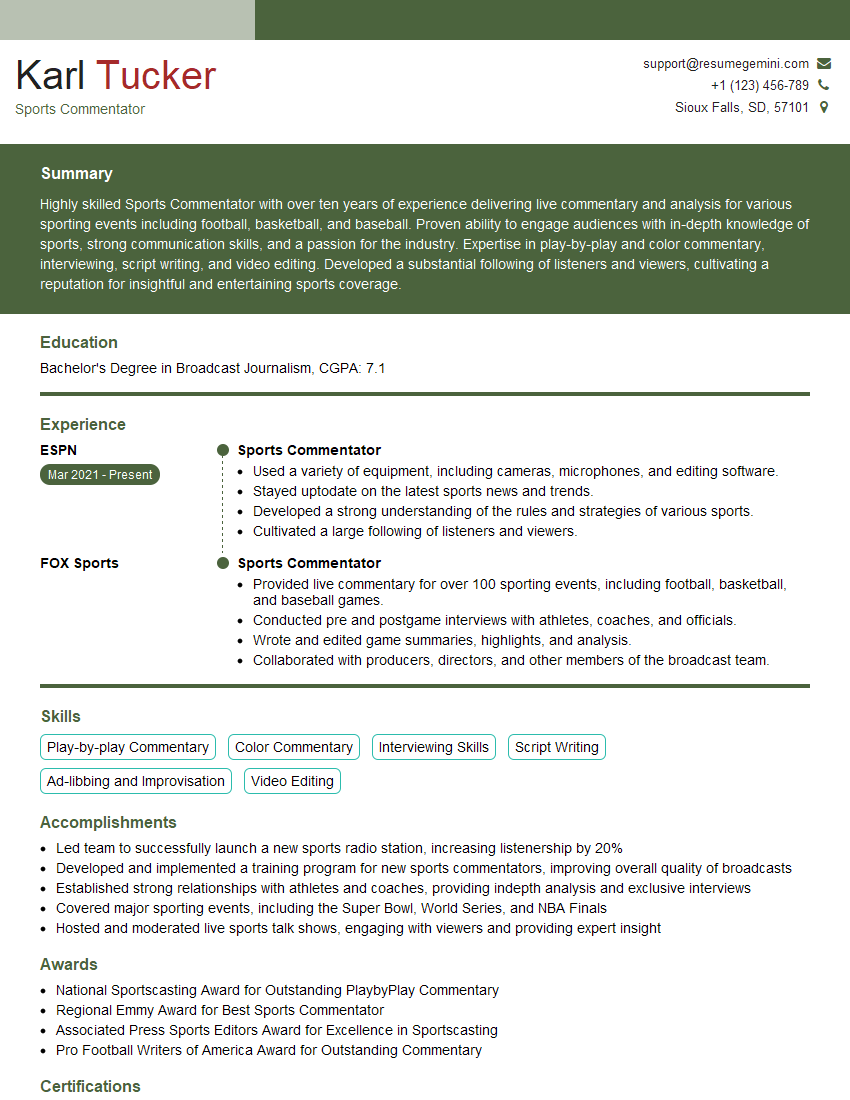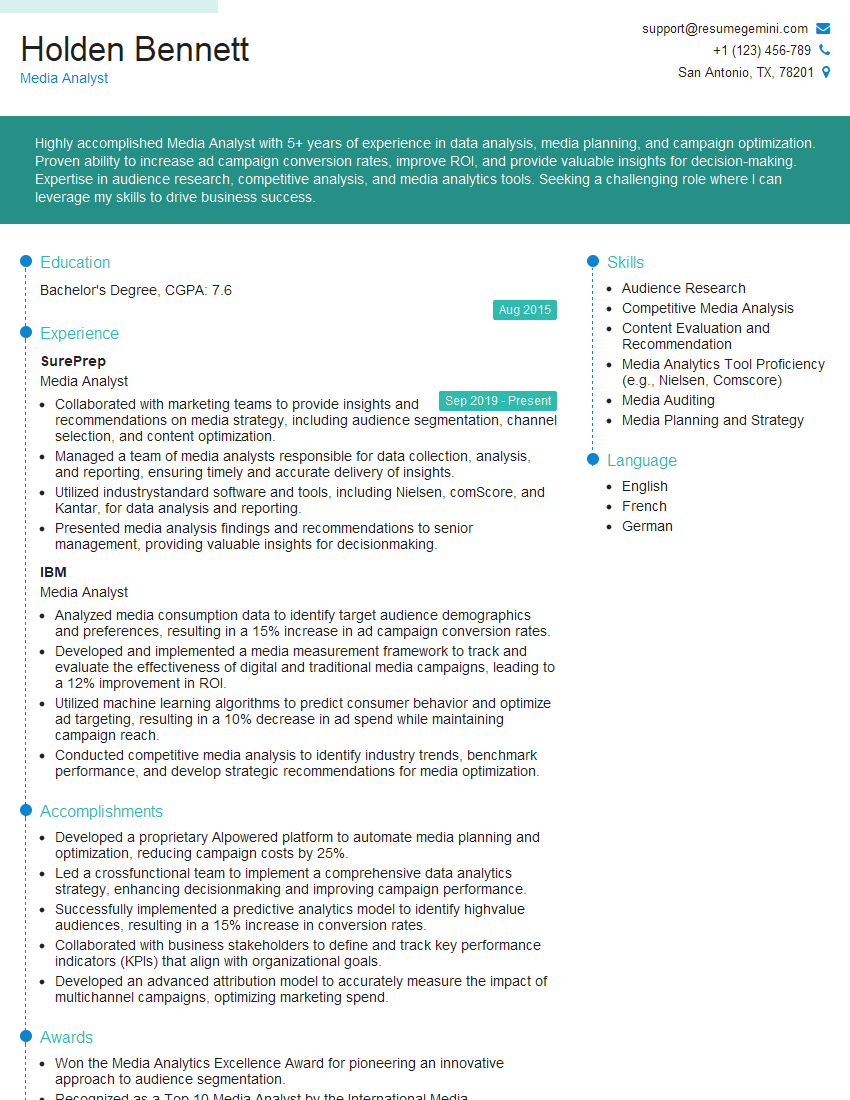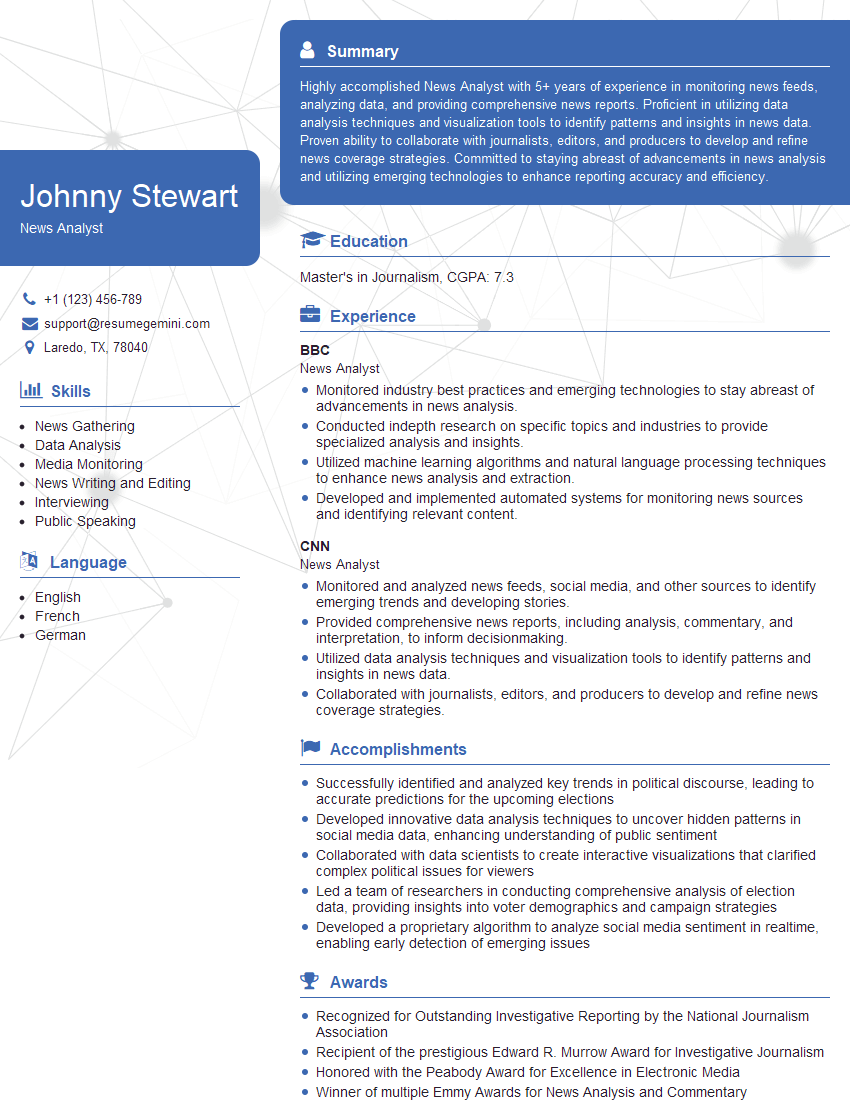Cracking a skill-specific interview, like one for Commentary and Analysis, requires understanding the nuances of the role. In this blog, we present the questions you’re most likely to encounter, along with insights into how to answer them effectively. Let’s ensure you’re ready to make a strong impression.
Questions Asked in Commentary and Analysis Interview
Q 1. Explain your understanding of the difference between commentary and analysis.
Commentary and analysis, while often used interchangeably, represent distinct approaches to interpreting information. Commentary offers an opinionated overview, providing a perspective on a topic often based on limited data or immediate observation. Analysis, conversely, involves a deeper, more methodical examination of data to identify patterns, draw conclusions, and support claims with evidence. Think of commentary as a snapshot, while analysis is a more comprehensive investigation.
Example: A sports commentator might offer commentary on a game’s exciting moments and the teams’ current performances, largely based on live observation. A sports analyst, however, would use statistical data like win-loss records, player statistics, and team strategies to analyze the game’s outcomes and predict future performance.
Q 2. How do you ensure objectivity in your commentary?
Objectivity in commentary is crucial for credibility. I ensure objectivity by diligently separating my personal opinions from factual reporting. This involves:
- Verifying Information: I cross-reference data from multiple reliable sources to ensure accuracy.
- Presenting Multiple Perspectives: I acknowledge and address differing viewpoints fairly, avoiding bias towards a single perspective.
- Avoiding Emotional Language: I use neutral language, focusing on factual details and avoiding subjective or emotionally charged terms.
- Transparency: I clearly state my sources and any potential conflicts of interest.
Example: In analyzing a political debate, I would present arguments from both candidates, noting their supporting evidence and potential weaknesses, rather than favoring one side based on my personal beliefs.
Q 3. Describe your process for analyzing complex data sets.
My process for analyzing complex datasets involves a structured approach:
- Data Cleaning and Preparation: This initial step involves handling missing data, identifying outliers, and transforming data into a usable format. Tools like SQL and Python libraries (pandas, numpy) are invaluable here.
- Exploratory Data Analysis (EDA): EDA uses visualization techniques (histograms, scatter plots) and summary statistics to understand the data’s distribution, identify patterns, and uncover potential relationships.
- Statistical Analysis: Depending on the research question, I employ appropriate statistical methods like regression analysis, hypothesis testing, or machine learning algorithms.
- Interpretation and Conclusion: The final step involves interpreting the results in context, drawing meaningful conclusions, and communicating findings effectively. I ensure that the conclusions are directly supported by the data analysis.
Example: Analyzing sales data for a company might involve cleaning the data for inconsistencies, then using regression analysis to determine the relationship between advertising spend and sales revenue, finally presenting the findings with clear visualizations and interpretations.
Q 4. How do you identify and address biases in your analysis?
Identifying and addressing biases is paramount. I employ several strategies:
- Self-Reflection: I acknowledge my own potential biases and actively work to mitigate their influence on my analysis.
- Peer Review: Seeking feedback from colleagues with diverse perspectives helps identify blind spots and biases I might have missed.
- Multiple Analytical Approaches: Using different analytical methods can reveal biases that might be present in a single approach.
- Sensitivity Analysis: Testing the robustness of results by changing parameters or assumptions exposes the impact of potential biases.
Example: If analyzing crime data, I would be conscious of potential biases in reporting or enforcement practices that could skew the results. I’d aim to control for these biases through careful data selection and statistical modeling.
Q 5. Explain a time you had to synthesize information from multiple sources for an analysis.
During a recent project assessing the impact of social media on political polarization, I synthesized information from various sources. This included academic research papers on social media algorithms and political behavior, polling data on voter sentiment, and news articles reporting on social media trends. I used a qualitative thematic analysis alongside quantitative statistical techniques to compare and contrast different findings. This multi-faceted approach revealed a more nuanced picture than relying solely on one data source.
Q 6. How do you communicate complex information clearly and concisely?
Communicating complex information effectively involves simplifying the message without sacrificing accuracy. I use several techniques:
- Clear and Concise Language: Avoiding jargon and using plain language ensures wider accessibility.
- Visual Aids: Charts, graphs, and other visuals help illustrate complex data points.
- Storytelling: Structuring the information as a narrative makes it more engaging and memorable.
- Layered Explanation: Providing a high-level overview followed by more detailed explanations caters to different levels of understanding.
Example: Instead of saying ‘The coefficient of determination (R-squared) indicates a strong positive correlation between variables X and Y,’ I might say ‘Our data shows a strong relationship between X and Y: as X increases, Y also tends to increase significantly.’
Q 7. Describe your experience with different forms of commentary (e.g., written, oral, video).
My experience spans various forms of commentary:
- Written Commentary: I regularly write reports, articles, and analyses, focusing on clarity, accuracy, and evidence-based conclusions.
- Oral Commentary: I’ve presented findings in conferences and workshops, adapting my communication style to the audience and context. This requires strong improvisation skills and the ability to respond to questions effectively.
- Video Commentary: I’ve participated in creating video presentations, using visual aids and concise messaging to effectively convey complex ideas. This format allows for a more dynamic and engaging delivery.
Each format demands different skills; written commentary prioritizes precision, oral commentary emphasizes engagement, and video commentary combines both aspects with visual storytelling.
Q 8. How do you handle conflicting information or perspectives when preparing commentary?
Conflicting information is inevitable in commentary. My approach involves a systematic process of triangulation and contextualization. First, I identify the core points of disagreement. Then, I examine the source of each piece of information, evaluating its credibility, bias, and methodology. This often involves checking the reputation of the source, looking for corroborating evidence from multiple independent sources, and considering any potential conflicts of interest. For instance, if one source is a government agency and another is an NGO, I’ll consider their differing perspectives and agendas. Finally, I present all significant perspectives fairly, acknowledging the uncertainty or debate where appropriate, rather than attempting to force a definitive conclusion if the evidence is inconclusive. This transparency builds trust with the audience.
Think of it like assembling a jigsaw puzzle with some missing pieces – you might not have a complete picture, but you can still present a coherent and informed narrative based on the pieces you do have, highlighting the gaps and uncertainties where they exist.
Q 9. Explain your approach to fact-checking and verification.
Fact-checking is paramount. My approach is multi-layered. I start with primary sources whenever possible – original documents, official reports, and data sets. I cross-reference information from multiple reputable sources to confirm accuracy. I also verify statistics and figures using independent sources, scrutinizing methodologies and looking for potential errors. For any claims that are crucial to my analysis, I meticulously trace their origins. If I encounter conflicting information, I delve deeper, analyzing the methodologies used, the potential biases of the sources, and the evidence presented to support each claim. This process may include consulting fact-checking websites and databases. I document all sources meticulously, ensuring that my analysis is transparent and easily verifiable.
For example, if I’m commenting on economic data, I wouldn’t just rely on a single news report. I’d also look at the original government statistics, compare them with data from international organizations, and cross-reference with independent economic analyses. This layered approach is crucial for producing credible and reliable commentary.
Q 10. How do you adapt your commentary style to different audiences?
Adapting my style depends heavily on the audience. For a highly specialized academic audience, I can use more technical jargon and delve into intricate details. For a general audience, I need to simplify complex concepts, avoid overly technical language, and focus on clarity and accessibility. For example, when explaining economic policy to economists, I might use terms like ‘fiscal multiplier’ and ‘monetary easing.’ However, when explaining the same topic to a general audience, I’d focus on the impacts on jobs, inflation, and daily living, using simpler language and relatable examples.
The medium also matters. A radio commentary requires a concise and engaging style, relying on strong narrative elements and impactful sound bites. A written piece allows for more detail and nuance. The tone needs to be tailored to the context – a formal news report requires a neutral tone, while an opinion piece can express more subjective viewpoints, provided they are well-reasoned and supported by evidence.
Q 11. Describe a time you had to revise your analysis due to new information.
I once wrote an analysis of the impact of a new environmental regulation on a specific industry. My initial analysis, based on publicly available data, predicted a significant negative impact on employment. However, shortly before publication, a detailed industry report surfaced, revealing a previously undisclosed government subsidy program that would largely offset the negative effects. This new information necessitated a complete revision of my analysis. I updated my commentary to reflect the mitigating impact of the subsidy program, acknowledging the initial error and explaining the reasons for the change. This transparency was crucial for maintaining credibility, demonstrating a commitment to accuracy and intellectual honesty.
This experience highlighted the importance of remaining flexible and open to new information. It’s crucial to acknowledge that our initial analyses are just working hypotheses, always subject to revision as new data emerges.
Q 12. How do you prioritize information when preparing commentary under tight deadlines?
Prioritizing information under tight deadlines requires a strategic approach. I begin by identifying the most critical elements of the story – the key facts, the central arguments, and the most significant implications. I then focus on those elements first, ensuring that they are accurately represented and well-supported. Less crucial details can be omitted or summarized briefly. This involves making difficult decisions about what to include and what to leave out. For example, if covering a complex policy announcement, I might prioritize the core policy changes, their likely economic impact, and the political implications, while relegating less significant details to a secondary role.
Using a prioritized list and a structured outline helps organize information efficiently, preventing information overload and ensuring that the commentary is focused and impactful despite the time constraints.
Q 13. What tools and technologies do you use for data analysis?
My data analysis workflow leverages several tools. For data cleaning and manipulation, I use Python with libraries like pandas and NumPy. For statistical analysis and visualization, I use R or Python with libraries like statsmodels, scikit-learn, and matplotlib. For handling large datasets, I utilize cloud-based platforms that offer scalable computing power. Database management systems like SQL are indispensable for efficient data organization and retrieval. I also use specialized software for specific data types – for example, geographic information systems (GIS) software for spatial data analysis.
The choice of tools depends on the specific dataset and the nature of the analysis. The goal is to select the most efficient and effective tool for the task at hand.
Q 14. How do you stay up-to-date on current events and industry trends?
Staying current requires a multi-faceted approach. I regularly read reputable news sources from a variety of perspectives to ensure a balanced understanding of events. I subscribe to relevant newsletters and podcasts that provide insights into industry trends and emerging issues. I actively participate in professional networks and attend conferences and seminars to engage with other experts and stay abreast of new developments. I also use social media strategically, filtering for authoritative accounts and relevant discussions, while acknowledging its limitations and potential biases. Crucially, I continuously refine my research skills, developing expertise in evaluating sources and critically assessing information.
Keeping up-to-date is an ongoing process, requiring dedicated effort and a commitment to lifelong learning. It is as important as mastering the technical skills required for in-depth analysis.
Q 15. How do you measure the effectiveness of your commentary or analysis?
Measuring the effectiveness of commentary or analysis isn’t a simple matter of counting likes or views. It requires a multifaceted approach considering both audience engagement and the impact of the analysis. I use several metrics.
- Audience Engagement: This includes metrics like the number of comments, shares, and the overall level of discussion generated. A piece that sparks debate, even negative, often signals a higher level of impact than one that is simply passively consumed.
- Behavioral Changes: For policy-oriented analysis, I look for evidence of shifts in policy or decision-making influenced by my work. Did the commentary lead to changes in strategy, policy adjustments or further investigation?
- Expert Feedback: I actively solicit feedback from colleagues and experts in the field. Their insights provide valuable perspectives I might miss.
- Data-driven metrics (where applicable): If my analysis is based on numerical data, I assess the accuracy of my predictions or the strength of correlations established. For example, if I predicted a market trend based on economic indicators, I’d track the actual market performance to validate my analysis.
Ultimately, effectiveness is judged by the extent to which my commentary informs, provokes thought, and potentially influences action or understanding.
Career Expert Tips:
- Ace those interviews! Prepare effectively by reviewing the Top 50 Most Common Interview Questions on ResumeGemini.
- Navigate your job search with confidence! Explore a wide range of Career Tips on ResumeGemini. Learn about common challenges and recommendations to overcome them.
- Craft the perfect resume! Master the Art of Resume Writing with ResumeGemini’s guide. Showcase your unique qualifications and achievements effectively.
- Don’t miss out on holiday savings! Build your dream resume with ResumeGemini’s ATS optimized templates.
Q 16. Describe your experience with qualitative versus quantitative analysis.
Qualitative and quantitative analysis are complementary approaches. Quantitative analysis relies on numerical data and statistical methods to identify patterns and relationships. For instance, analyzing election results to determine voter demographics requires quantitative analysis.
Qualitative analysis, on the other hand, focuses on exploring themes, interpretations, and underlying meanings. It often involves interviews, textual analysis, or case studies. A qualitative analysis of political speeches could focus on identifying rhetorical devices used and their intended effect.
My experience spans both. I frequently blend them. For example, I might use quantitative data on crime rates to support a qualitative analysis discussing the root causes of crime in a particular neighborhood. This mixed-methods approach offers a more robust and complete understanding.
Q 17. Explain your approach to formulating a strong argument or opinion.
Formulating a strong argument involves a structured process. It’s not about personal opinion, but rather a well-supported claim.
- Establish a clear claim: The argument must have a central thesis statement that is specific, arguable, and concise.
- Gather evidence: This evidence can be quantitative (data, statistics), qualitative (case studies, expert opinions), or a combination of both. Each piece of evidence must be rigorously sourced and properly cited.
- Address counterarguments: Acknowledging opposing viewpoints and refuting them strengthens the argument. This shows a nuanced understanding of the issue.
- Logical structure: The argument should flow logically, with each point supporting the central claim. Using clear transitions between points helps the reader follow the line of reasoning.
- Concise and clear writing: Avoiding jargon and using precise language makes the argument easier to understand.
For example, arguing for stricter gun control wouldn’t just involve statistics on gun violence; it would also involve addressing counterarguments about self-defense rights and the Second Amendment, while presenting data on successful gun control measures in other countries.
Q 18. How do you handle criticism of your commentary or analysis?
Criticism is an inevitable part of providing commentary and analysis. Instead of viewing it as a personal attack, I see it as an opportunity for growth and improvement. My approach involves:
- Careful Consideration: I carefully examine the criticism, determining whether it addresses factual inaccuracies, flaws in logic, or simply differing perspectives.
- Engagement (where appropriate): If the criticism is constructive and well-reasoned, I engage in a respectful dialogue, clarifying points of misunderstanding or acknowledging areas for improvement. This often involves revisiting my analysis and re-evaluating my approach.
- Ignoring unproductive criticism: I don’t engage with criticism that is purely abusive or lacks substance.
- Learning from mistakes: Even valid criticism can highlight blind spots in my understanding. This learning process is invaluable in refining my analytical skills and improving future work.
Ultimately, managing criticism professionally helps to improve the quality of my work and build credibility.
Q 19. What are some ethical considerations in providing commentary and analysis?
Ethical considerations in commentary and analysis are paramount. My work adheres to the following principles:
- Accuracy and Truthfulness: All claims must be supported by credible evidence. Misrepresenting data, fabricating information, or engaging in plagiarism are unacceptable.
- Objectivity and Impartiality: While expressing opinions, it’s crucial to avoid bias and present information fairly. Transparency about potential conflicts of interest is also vital.
- Context and Nuance: Presenting information out of context can lead to misinterpretations. I strive to offer a complete picture, acknowledging the complexities of the issue at hand.
- Responsibility for Impact: Commentary can influence public opinion and actions. It’s important to be mindful of the potential consequences of my work and to avoid contributing to misinformation or harmful narratives.
A prime example of unethical analysis would be cherry-picking data to support a predetermined conclusion, ignoring conflicting evidence, or using emotionally charged language to manipulate the audience.
Q 20. Describe your experience working with data visualization tools.
Data visualization is a critical skill for effective communication of analytical findings. My experience includes using various tools, such as:
- Tableau: For creating interactive dashboards and visualizing complex datasets.
- Power BI: Similar to Tableau, it’s excellent for creating reports and sharing insights.
- Python libraries (Matplotlib, Seaborn): For generating customized plots and charts, often integrated with statistical analysis.
I choose the tool based on the specific needs of the project and the technical skills of the intended audience. For example, a simple bar chart in Excel might be sufficient for a quick presentation, while a complex interactive dashboard built in Tableau might be necessary for a more in-depth report.
Q 21. How do you contribute to a team’s analytical efforts?
In a team setting, my contributions involve:
- Collaborative Analysis: I actively participate in brainstorming sessions, contributing ideas and perspectives to shape the analytical direction.
- Data Gathering and Cleaning: I assist in collecting and preparing data for analysis, ensuring its accuracy and reliability.
- Methodological Expertise: I share my knowledge of various analytical techniques to ensure that the team selects the most appropriate approaches.
- Presentation and Communication: I work collaboratively to present the findings clearly and effectively to both technical and non-technical audiences.
- Mentoring: Where applicable, I help to mentor junior team members by providing guidance and training in data analysis and communication.
My goal is to enhance the team’s collective understanding and contribute to the creation of high-quality, impactful analysis.
Q 22. How do you explain complex ideas to non-experts?
Explaining complex ideas to non-experts requires a shift from technical jargon to clear, concise language and relatable analogies. I approach this by first identifying the core concept – what’s the single most important takeaway? Then, I break it down into smaller, digestible chunks, using simple language and avoiding unnecessary technical terms. Visual aids, such as charts, graphs, or even simple diagrams, are invaluable in this process. Finally, I always check for understanding, encouraging questions and clarifying any points of confusion. For example, if explaining the concept of inflation to someone unfamiliar with economics, I wouldn’t start with equations. Instead, I’d use a real-world example like the rising price of groceries or gasoline, relating it to the increase in the overall cost of goods and services.
Think of it like building a house: you wouldn’t start by explaining the intricacies of the foundation’s concrete mix. You’d start with the overall design, showing the blueprint, then gradually explain the individual components – walls, roof, etc. – using simple language.
Q 23. Explain your understanding of different analytical frameworks (e.g., SWOT, PESTLE).
Analytical frameworks are essential tools for structuring and interpreting complex information. SWOT analysis (Strengths, Weaknesses, Opportunities, Threats) helps evaluate an organization’s internal capabilities and external environment, identifying potential advantages and challenges. For instance, a new coffee shop might identify its strong customer service as a strength, high rent as a weakness, a growing demand for organic coffee as an opportunity, and increasing competition as a threat. PESTLE analysis (Political, Economic, Social, Technological, Legal, Environmental) provides a broader macroeconomic perspective, assessing factors impacting a business or project. For example, launching a new app might consider potential government regulations (legal), changing consumer preferences (social), economic growth (economic), and the impact of climate change on supply chains (environmental). I often use these frameworks in conjunction with each other, allowing for a deeper and more nuanced understanding of the subject matter. The key is to adapt the framework to the specific context and tailor the analysis to the questions at hand.
Q 24. How do you use data to support your arguments?
Data is the bedrock of strong arguments. I use data to both support my claims and to demonstrate the strength of my conclusions. This involves selecting relevant data sets, performing appropriate statistical analyses, and then clearly communicating the findings. For example, if analyzing the effectiveness of a marketing campaign, I would use data on website traffic, conversion rates, and sales figures to show the campaign’s impact. This isn’t just about presenting raw numbers; it’s about interpreting those numbers in a way that’s meaningful and persuasive. Visualizations like charts and graphs are crucial for effective communication. A well-crafted chart can convey complex trends instantly, making your analysis more accessible and impactful. Transparency is key; I always clearly cite my sources and methodologies to ensure credibility and enable others to replicate my findings.
Q 25. What is your process for identifying key insights from data?
Identifying key insights from data is an iterative process that involves several steps. First, I explore the data to understand its structure and identify any potential issues like missing values or outliers. Then, I employ a variety of statistical techniques – descriptive statistics, correlation analysis, regression analysis, etc. – depending on the research question and data type. Data visualization plays a crucial role; creating charts and graphs helps to reveal patterns and trends that might be missed in raw data. However, the most crucial step is interpretation. I don’t just report the findings; I analyze them to draw meaningful conclusions and identify any implications. For example, if analyzing sales data, I wouldn’t just present the total sales figures; I’d identify trends, seasonality, and any significant changes over time, and I’d relate these findings to market conditions or marketing campaigns.
Q 26. Describe your experience presenting your analysis to stakeholders.
Presenting analysis to stakeholders requires tailoring your communication style to your audience. I start by understanding their level of knowledge and their key interests. Then, I structure my presentation to focus on the most relevant findings and conclusions, using clear and concise language, visual aids, and storytelling to convey complex information effectively. I always emphasize the implications of my findings, focusing on actionable insights and recommendations. Active listening during the Q&A session is crucial, allowing me to address any concerns and refine my explanations. For instance, when presenting to a board of directors, I would focus on the financial impact and strategic implications of my analysis, while presenting to a marketing team, I’d emphasize customer behavior and campaign performance. Preparation is key; rehearsing my presentation allows for smoother delivery and confidence in answering questions.
Q 27. How do you manage conflicting deadlines when working on multiple projects?
Managing conflicting deadlines requires effective prioritization and time management skills. I utilize project management techniques like creating a detailed schedule, breaking down large tasks into smaller, manageable ones, and assigning realistic deadlines to each. Communication is crucial; I proactively update stakeholders on progress and any potential delays. When faced with truly conflicting deadlines, I evaluate the urgency and importance of each project, prioritizing those with the highest impact. I also leverage tools like project management software to track progress and identify potential bottlenecks. Delegation, when possible, can significantly alleviate pressure and allow for efficient use of resources. Finally, I don’t hesitate to ask for help or clarification if I’m unsure about a deadline or priority.
Q 28. How do you ensure the accuracy and reliability of your sources?
Ensuring the accuracy and reliability of sources is paramount. I employ a multi-pronged approach: First, I evaluate the credibility of the source. Is it a reputable organization, a peer-reviewed journal, or a known expert? Then, I cross-reference information from multiple sources to confirm its validity. I scrutinize the methodology and data used to support the claims. For qualitative sources, I assess the author’s biases and potential conflicts of interest. I avoid using sources that lack transparency or proper attribution. Finally, I always cite my sources meticulously, allowing others to independently verify my findings. Maintaining a detailed record of my research process, including all sources consulted, is essential for accountability and reproducibility. Think of it like a detective investigating a case – every piece of evidence needs to be carefully examined and verified before it can be used to support a conclusion.
Key Topics to Learn for Commentary and Analysis Interview
- Understanding Different Commentary Styles: Explore the nuances of objective vs. subjective commentary, factual reporting vs. opinion pieces, and adapting your style to different audiences and platforms.
- Data Interpretation and Synthesis: Practice extracting key insights from complex data sets, presenting them concisely, and drawing meaningful conclusions supported by evidence.
- Narrative Structure and Argumentation: Develop strong storytelling skills to build compelling narratives. Master techniques for constructing logical arguments and supporting them with credible evidence.
- Critical Thinking and Bias Detection: Hone your ability to identify biases in information sources and critically evaluate the validity of arguments presented by others.
- Effective Communication Techniques: Refine your written and verbal communication skills to ensure clear, concise, and impactful delivery of your analysis. Consider the impact of tone and word choice.
- Research and Fact-Checking Methodology: Learn best practices for conducting thorough research, verifying information from multiple sources, and ensuring accuracy in your commentary.
- Ethical Considerations in Commentary: Understand the importance of fairness, objectivity, and responsible reporting in your analysis, and the potential consequences of biased or inaccurate information.
Next Steps
Mastering commentary and analysis is crucial for career advancement in many fields, opening doors to influential roles requiring strong communication, critical thinking, and insightful interpretation. A well-crafted resume is your first impression, and an ATS-friendly resume significantly increases your chances of getting noticed by recruiters. To build a standout resume that highlights your skills and experience in commentary and analysis, we highly recommend using ResumeGemini. ResumeGemini provides a user-friendly platform and offers tailored examples to help you create a compelling document that showcases your expertise. Examples of resumes specifically tailored for Commentary and Analysis roles are available within the ResumeGemini platform.
Explore more articles
Users Rating of Our Blogs
Share Your Experience
We value your feedback! Please rate our content and share your thoughts (optional).
What Readers Say About Our Blog
Hi, I represent an SEO company that specialises in getting you AI citations and higher rankings on Google. I’d like to offer you a 100% free SEO audit for your website. Would you be interested?
Hi, I represent an SEO company that specialises in getting you AI citations and higher rankings on Google. I’d like to offer you a 100% free SEO audit for your website. Would you be interested?
Dear Sir/Madam,
Do you want to become a vendor/supplier/service provider of Delta Air Lines, Inc.? We are looking for a reliable, innovative and fair partner for 2025/2026 series tender projects, tasks and contracts. Kindly indicate your interest by requesting a pre-qualification questionnaire. With this information, we will analyze whether you meet the minimum requirements to collaborate with us.
Best regards,
Carey Richardson
V.P. – Corporate Audit and Enterprise Risk Management
Delta Air Lines Inc
Group Procurement & Contracts Center
1030 Delta Boulevard,
Atlanta, GA 30354-1989
United States
+1(470) 982-2456
